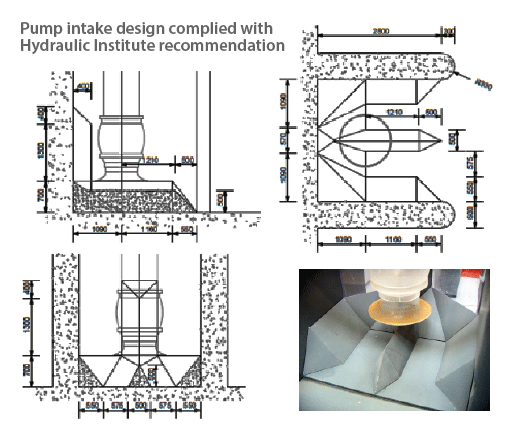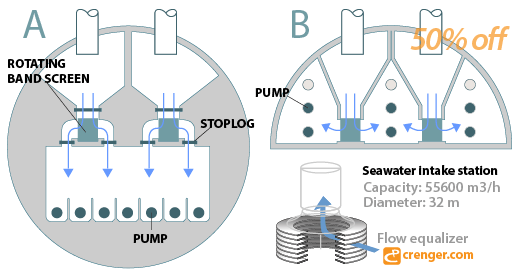
Without doubt, innovations are an indicator of business health. To innovate means to think like an engineer. Unfortunately richer experience does not automatically lead to better if any innovations. One of the reasons is shortcuts – the bulk of existing engineering standards and industry practices. Below is an example how they work in the seawater intake design.
Intake is a first component of seawater desalination plant; it defines the plant production and scenarios for future extension. It serves 3 tasks: inlet piping pigging, coarse water filtration, and, of course, pumping. First 2 tasks require roughly 50% of the intake cross section.
To error-proof the intake hydraulic design, Hydraulic Institute developed recommendations (HIR). With time they turned into industry standard, the latest being ANSI/HI 9.8-2018.
It is a 130-odd-page book explaining how to minimize the adverse impacts of the intake structure hydraulics on the pump performance – vortices, non-uniform spatial distribution of fluid velocities, entrained air, etc.
In a nutshell, HIR are all about how to straighten the water flow entering the pump. They are simple for understanding and implementation and invariably produce satisfactory performance.
Figure above shows a fragment of the vertical pump suction chamber. Its geometry is sophisticated but complies with HIR. Simpler options are usually not considered due to high cost of hydraulic modeling. For undistorted scale of 1:8 and big capacities it may be above $US30.000. CFD modeling is usually 20% less. Considerable prior experience and ingenuity are required to select proper operation modes and get meaningful results from the intake modeling. Both physical and CFD models are built on Froude-number similitude.
The notorious 5D rule (defining the distance from the pump inlet centerline to the intake structure inlet) leads to spatial design with high civil engineering costs. For the seawater intake of 55000 m3/h, they may reach $US 5.5 – 7.5 million, the concrete structure outer diameter being over 32 meters (Figure 2, option A).
Though HIR are completely voluntary, engineers consider them a Bible, any intake design not conforming to HIR is often discarded, even if it has superior hydraulics.
This situation is an example of the orthodoxy of engineering thinking rooted into existing engineering standards. (We forget that they are intended to protect the client from inferior engineering, not to anchor the engineer's imagination.) Blindly following the standards often creates a dead zone where analogical and deductive reasoning, rhetoric, and critical thinking stop working.
How to break out of this zone?
Ask a question - can we straighten the flow differently?
A simple contraption – the flow straightener - shown in the figure below makes HIR irrelevant as it entirely changes the problem context. This device disconnects the pump suction conditions from the intake hydraulics. It wakes up the engineering thinking and it immediately leads to a design half the size of the conventional one.
Next step is how to combine more reliable but inefficient rotating band screens with less reliable vertical pumps. Results may be not less surprising.

